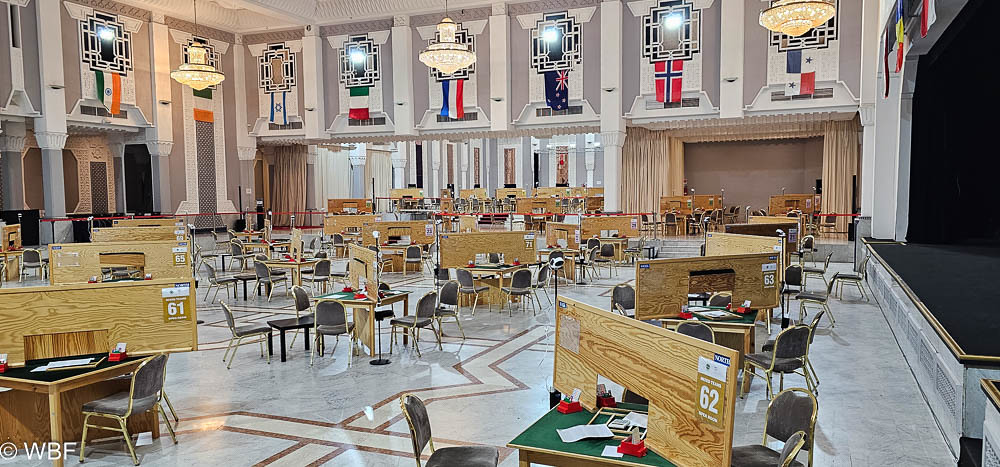



We have returned to Europe, and the small town of Veldhoven, located southwest of Eindhoven in southern Netherlands. For the next week, this will be the venue for the World Youth Bridge Championships. This is our chance to see the brightest young stars of tomorrow from all around the world, as they compete for World titles in five categories. The marquee event is the Junior Teams (or the Under-26 Teams), with some teams containing players who have already won numerous World Championship titles, some of them in non-age restricted events. The other categories are Under-26 Girls Teams, Youngsters Teams (Under-21), Schools Teams (Under-16) and Universities Teams (Under-31).
The format is a five-day round robin with the top eight teams advancing to the knockout stage at the end of the week. The number of matches in the round robins varies according to the number of teams in each category. The largest event is the Junior Teams, with 24 teams, so they will play 23 rounds.
As usual, we start with some problems. Firstly, with neither side vulnerable, you are East holding:
What action, if any, do you take?
Next, with both sides vulnerable, you are sitting in the South seat with:
What action do you take?
Finally, with only your opponents vulnerable, you hold in the North chair:
What, if anything, do you bid now?
While you consider those, we start with a match between the bookies’ pre-tournament favourites in the Junior Teams, Sweden, and the home-town favourites, Netherlands. The Dutch team are coached by former Bermuda Bowl winner Wubbo de Boer. The Swedish team includes two pairs (Clementsson/Sandin and Hansson/Mann) who have already won both the European and World Under-21 titles. Sanna Clementsson, aged just 23, has also won the Venice Cup twice and the European Mixed Teams titles.
Those watching live on BBO VuGraph did not have to wait long for the action to start. On the opening deal of the championships, both East players had to answer the first of the problems above.

Many of you will recognize Sanna Clementsson (left) as she is the youngest member of the BBO expert bidding panel. She will also be featured as one of the ‘Rising Stars’ in my upcoming book, “World Class II”, the sequel to the 1999 original.
The destination of the IMPs on this deal was down to the choices made by the E/W pairs. For the Dutch, Stefan Thorpe got into the auction with a double of Alexander Sandin’s pre-emptive raise to 4♠. The usual principle in this type of auction is that you should remove high-level doubles if you expect to be close to making your contract. It is therefore far from clear that Sibrand van Oosten’s final pass is wrong on these East cards, although it certainly did not work well on this layout.
There were just three red-suit tricks for declarer to lose. N/S +590. Whilst I have plenty of sympathy for Van Oosten’s pass of his partner’s double (which will often be made on a strong NT hand type in this auction), I wonder if double is the best choice on the West hand. A 4NT takeout is certainly a viable alternative, although before making that bid you had better decide what you plan on doing if partner removes to 5♦. Are you going to pass or advance to 5♥, treating your hand as a heart/club two-suiter, even though most of your points are in the short suit. Not an easy combination for E/W, as we shall see.

For the Swedes, Castor Mann also doubled 4♠. In the same position as his Dutch counterpart at the other table, but Erik Hansson (right) opted to remove to his six-card suit.
Oscar Nijssen led the ♣J to his partner’s ace and ruffed the club return. His heart exit then went to the queen and king. After drawing the remaining trumps, Hansson had no problem taking the rest of the tricks. E/W +400 and 14 IMPs to SWEDEN to open the match,
Even if Nijssen leads a spade, declarer can still get home due to the fortunate lie of the heart suit. Declarer ruffs with the ♦J, draws two rounds of trumps with the ♦A-K, then plays a heart to the jack. The finesse winning is not all declarer needs, though. It is only because South must follow to three rounds of hearts that the contract makes. Declarer can therefore discard his second spade on the fourth round of heart as South ruffs with his trump winner. Had South been able to ruff the third heart, the defence would then have been able to score a trick in each black suit in addition to the ♦Q.
At the 24 tables in play in the Junior Teams, only four E/W pairs (Italy, Singapore and France were the other three) bid and made game in diamonds. At five table, N/S took the cheap save in 5♠-X for -100. At the others. N/S made +420 in 4♠ (9 times), +590 in 4♠-X (4 times), and +170 in 3♠ and +480 in 4♠ (once each).
There was another bidding test for E/W just a few deals later. Regular partnerships might consider how they would handle the situation in which the Swedish pair came a cropper here…
The Dutch N/S did well to get the auction up the four-level before West got a second bid on his monster hand. Facing Mann’s takeout double, Hansson advanced with 4NT, presumably showing two places to play. It seems reasonable to me for Mann to bid 5♣ – suppose East has something like a 2-4-2-5 shape, might this not be the right contract? Quite why Hansson passed is something of a mystery – did he not bid 4NT intending to offer a choice between the red suits? Apparently not. 5♣ was not the happiest of spots. Declarer could not avoid losing a diamond and two trumps. E/W -100.
At the other table, the Swedes did not exert quite as much pressure, nor as quickly...

Since making his international debut in the French Under-21 team at the 2017 World Youth Championships, Stefan Thorpe (left) has represented France, Austria and, now, Netherlands in Junior Teams at major championships.
Alexander Sandin’s gentle raise to 3♠ allowed Thorpe to bid his suit at the four-level. He had then heard his partner raise before he had to make the key decision when South bid a fifth spade. Thorpe judged well to bid the slam, which made comfortably when trumps came in for only one loser. E/W +1370 and 16 IMPs to NETHERLANDS.
SWEDEN won an exciting opening match 32-21. The early pace-setters in the Junior Teams were CHINA and JAPAN, both recording 20-0 wins.
Let’s take an early look at the CHINA team in action, against AUSTRALIA in Round 2. Both South players heard the auction as presented in this week’s second problem.
For the Australians, Tomer Libman came in with a 2♠ overcall of East’s 1NT response. It was hardly obvious that Sebastian Langdon-Macmillan should take action on the North hand, but there was just one club, one heart and one trump to be lost. N/S +170.

Benjie Miao (right) and Sijia Gu both made their international debut in China’s Youngsters team at the 2014 World Youth Championships. They had moved up into the Junior team together for the last pre-pandemic World Championships attended by the Chinese, in 2018. They come to Veldhoven now as the most experienced partnership in this China team.
After the same start to the auction, Miao decided that the South hand was too strong for a simple 2♠ overcall, and instead began with a takeout double of hearts. When David Gue rebid his hearts, Gu made a value-showing responsive double on the North cards. That was all the invitation Miao needed to jump to the good game. Well judged from both sides of the table. N/S +620 and 10 IMPs to CHINA.
CHINA won the match 29-6 and remain top of the early table with 36.18 VPs from a possible 40.
We conclude this maiden visit to Veldhoven with our first look at the Youngsters Teams. After three matches, it was JAPAN and ISRAEL making the running at the top of the table. The BBO VuGraph match from Round 4 was ISRAEL against USA1, who were not far behind, in sixth place at this early stage.

Although not the perfect shape, it was certainly not unreasonable for Olivia Schireson to treat this South hand as a 1NT opening. Michael Xu (left), a member of the USA team that won the World Under-26 Teams in Salsomaggiore last year, transferred to spades and then jumped to 4♦, an auto-splinter, showing a shortage in that suit and self-agreeing his own spade suit. When Schireson retreated to 4♠, Xu was then left with the last of this week’s problems.
Despite his partner’s lack of interest, Xu chose to press on with RKCB. When he found that only one key-card was missing, he chose to take a shot at slam. Perhaps we can blame the inherent optimism of youth, but slam was not good.
At first glance, the contract seems to depend on finding East with a doubleton ♣K, but Schireson did manage to improve on those odds. The ♥10 was led and ducked around to declarer’s queen. Schireson cashed the ♦A and ran the ♦Q, discarding the remaining heart from dummy. Now, at least, declarer ‘only’ needed to find the clubs finesse working. East’s club return did not bode well, but declarer had little choice but to take the finesse. West therefore won with the ♣K and took a club ruff for two down. N/S -100.

Daniel Msika (right) made his international debut as a member of the Israel Schools team that won silver medals at the 2017 European Youth Championships. He then paired up with Ido Moskovitz and, together, they won the European Schools Teams title in 2019 and collected bronze medals in the Under-26 Teams at the 2022 European Championships here in Veldhoven. One of the most experience partnerships in the Youngsters Teams at these championships, their presence surely makes Israel one of the pre-tournament favourites,
Moskovitz started with a 1♦ opening and rebid 2♣ over Msika’s 1♠ response. Msika continued with a forcing jump to 3♠, and then a self-agreeing cue-bid over Moskovitz’s 3NT. East’s double certainly did not improve Msika’s hand so, despite Moskovitz’s encouraging pass, he shut up shop in the relative safety of game.
East led a club and Msika took no chances, rising with the ♣A and drawing trumps. The defenders got the ♣K and the ♥A, but that was all. N/S +650 and 11 IMPs to ISRAEL.
The Americans had the better of the rest of the match and emerged with a win by 30-23 to climb just ahead of their opponents into fourth place. At the end of the first day, the Youngsters Teams is led by JAPAN, followed by ENGLAND, POLAND and USA1.
In the Junior Teams, CROATIA have climbed to the top of the leader-board (after five matches), with SWEDEN, FRANCE and USA1 close behind.
At the end of the opening day, the leaders in the other events are:
Under-26 Girls Teams: DENMARK, NETHERLANDS, ITALY.
Schools Teams: CHINA, USA1, ISRAEL.
Universities Teams: ISRAEL, INDIA, CHINA.
We will be back soon with the best of the action from Day 2.



